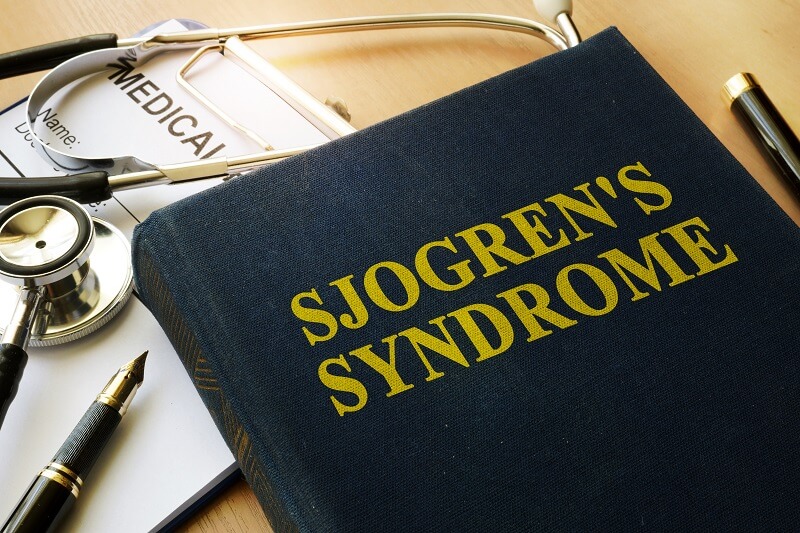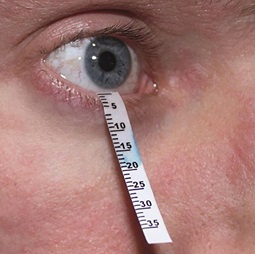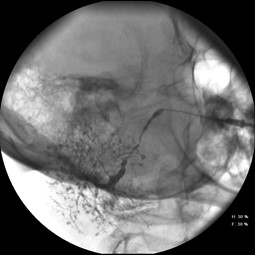SJOGRENS DISEASE

General: Sjogrens syndrome is an autoimmune disease that often causes joint pain. The disease has a wide variety of symptoms, but is usually identified by two common characteristic symptoms: dry eyes and dry mouth. In the US, 1-2 million people are believed to have Sjogrens syndrome, mostly middle aged women.
Causes: Sjogrens syndrome is an immune system disorder, but its exact cause is unknown. There may be a predisposing genetic component, but it is thought that an environmental trigger or virus leads to activation of the body’s immune system.
When the immune system is activated in Sjogrens syndrome, specific glands in the body that make tears and saliva are targeted, causing degeneration, atrophy, and decreased function. The immune system dysfunction can affect other parts of the body, including joints, kidneys, lungs, skin, thyroid, and nerves.
Symptoms: The hallmark symptoms of Sjogrens syndrome are dry eyes (keratoconjunctivitis sicca, or KCS), and dry mouth (xerostomia). The eyes become relentlessly dry, itchy, and irritated. This can affect vision. With dry mouth, there is difficulty eating and swallowing due to decreased saliva production. There may also be an increase in dental cavities with the loss of saliva that normally protects teeth.
Because Sjogrens syndrome’s immune system dysfunction can affect other parts of the body, there may be symptoms related to pneumonia/bronchitis, nerve dysfunction, and liver disease.
Diagnosis: Diagnosing Sjogrens syndrome is challenging for several reasons. There is no single test to definitely diagnose Sjogrens syndrome. Also, signs and symptoms can vary widely from person to person. Because many of the symptoms of Sjogrens syndrome are found in other diseases, the diagnosis often results from a long process of ruling out other conditions. This often requires input from several specialists.
There are diagnostic findings that can help diagnose Sjogrens syndrome related to its most characteristic symptoms, dry eyes and dry mouth. On physical examination, the eyes will be dry and red, and the mouth will be dry, cracked and irritated. The face may be swollen. There may be many other clinical findings related to problems in the lungs, kidneys, nerves, and the digestive system. Joints may be tender and swollen.
Blood tests can help confirm the diagnosis of Sjogrens syndrome. Some blood tests like ESR (erythrocyte sedimentation rate) and CRP (c-reactive protein) can measure high levels of inflammation to raise suspicion for immune system disorders. With the dysfunctional immune system, autoantibody proteins are released that Rheumatoid factor (RF) and antinuclear antibodies (ANA) may be elevated, especially if there is another coexisting autoimmune disorder. There are specific antibody patterns common in Sjogrens syndrome can help to make the diagnosis. These anti-SSA and anti-SSB (anti-ro and anti-la) are highly suggestive of Sjogrens syndrome.
Eye specialists can use slit lamp examination, and can conduct Shirmer’s test, to gather evidence needed to diagnose Sjogrens syndrome. Shirmer’s test is a simple procedure that measures tear production with a small piece of fliter paper placed near your eyelid. Special imaging testing can be done to assess salivary gland function. A lip biopsy, which is a small tissue sample that is examined under a microscope, can be taken to evaluate salivary gland changes consistent with Sjogrens.


Treatment: there is no known cure for Sjogrens syndrome, so treatment is geared towards treating and suppressing symptoms.
For dry eyes, artificial tears and lubricants can help maintain moisture. Slow-release tear pellets can help When eyes become inflamed, prescription eyedrops may be recommended.
For dry mouth symptoms, salivary substitutes and stimulation may help. Gum and lozenges can help. Because dry mouth can lead to cavities and infections, dental care is extremely important. Mouth-coating gels can be used to help for nighttime mouth dryness.
There are systemic treatments (oral and injectable medications) for diffuse symptoms throughout the body. Corticosteroids and anti-inflammatory medications can be helpful in controlling inflammation related to the immune system dysfunction, especially for joint aches. Hydroxychloroquine and immune system modulators (disease modifying antirheumatic drugs, or DMARDs) such as methotrexate may also be prescribed to help control symptoms related to Sjogren’s syndrome.
Self-management: Many people can successfully manage the common symptoms of dry eye and dry mouth with simple home treatments. Regardless, review these treatments with your doctors.
- Dry eyes: Artificial tears or topical eye lubricants can relieve eye discomfort. It is important to avoid exposure to air or wind blowing directly into the eyes, which can worsen dryness. This may require wearing sunglasses or staying inside on windy days, as well as avoiding sitting in front of vents and fans.
- Dry mouth: Consistent hydration is generally important. Frequent sips of water at mealtime can help keep the mouth moist to assist with chewing and swallowing. Sugar-free gum and lemon lozenges can help increase and maintain saliva production.
- Dental health: Along with maintaining saliva in the mouth, avoid acidic beverages that harm enamel and minimize sweets between meals. Practice excellent dental hygiene, which includes diligent brushing, flossing, and mouthwashes. Regular visits to the dentist are extremely important.
- Dry skin/mucosa: Moisturizing lotions and avoidance of rubbing can help with dry skin. Moisturizers and lubricants can help prevent vaginal dryness.
- General: Quit smoking and avoid exposure to tobacco products. Always aim for a healthy diet that includes anti-inflammatory foods. Maintain a healthy weight to minimize joint stress.
Other Topics That Interest You


